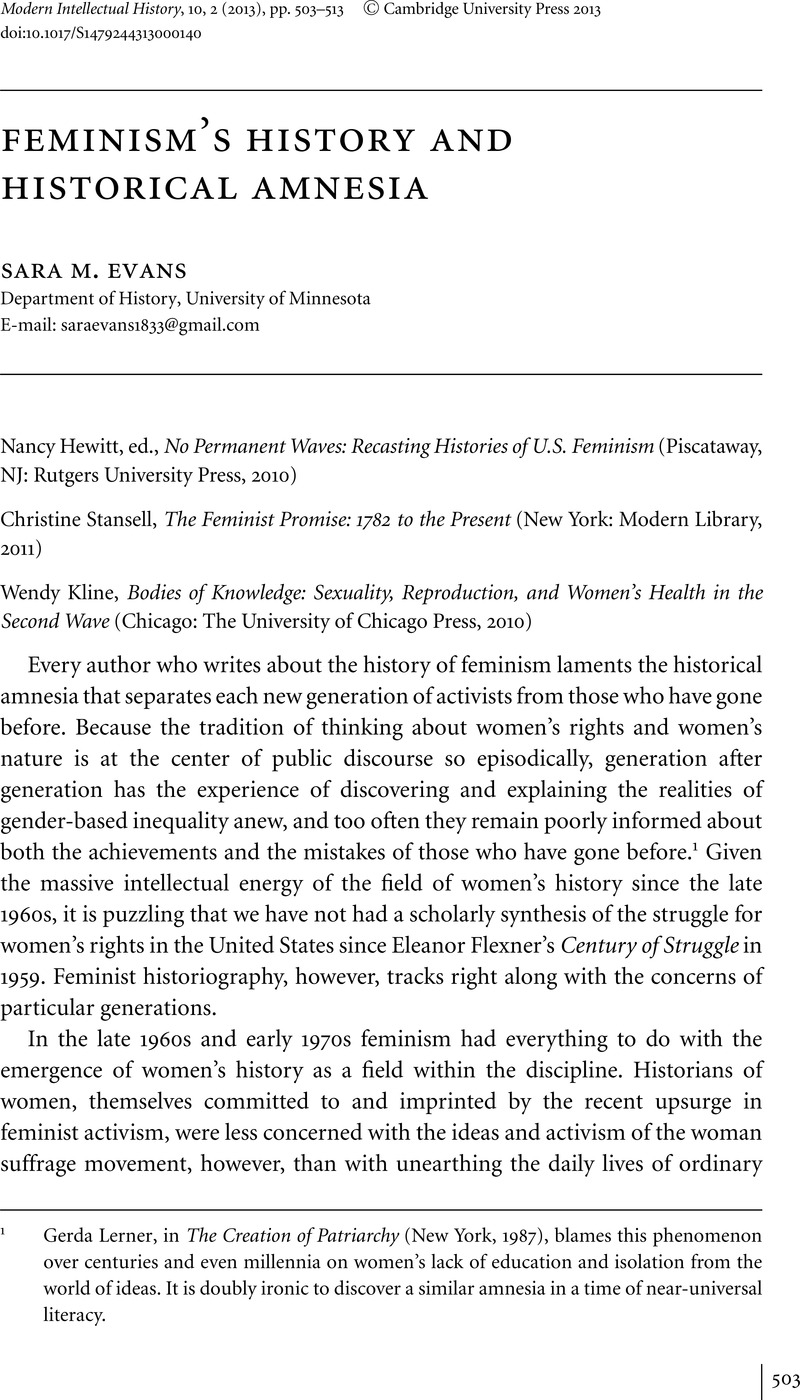No CrossRef data available.
Article contents
FEMINISM'S HISTORY AND HISTORICAL AMNESIA
Review products
Published online by Cambridge University Press: 11 July 2013
Abstract

- Type
- Review Essays
- Information
- Copyright
- Copyright © Cambridge University Press 2013
References
1 Lerner, Gerda, in The Creation of Patriarchy (New York, 1987)Google Scholar, blames this phenomenon over centuries and even millennia on women's lack of education and isolation from the world of ideas. It is doubly ironic to discover a similar amnesia in a time of near-universal literacy.
2 I was one of the few working on the history of contemporary feminism but my work focused on the origins of the women's movement in the 1960s and I did not try to write a history of that movement itself for more than two decades.
3 See Evans, Sara M., Personal Politics: The Roots of Women's Liberation in the Civil Rights Movement and the New Left (New York, 1979)Google Scholar; and Hall, Jacquelyn Dowd, Revolt against Chivalry: Jesse Daniel Ames and the Women's Campaign against Lynching (New York, 1979)Google Scholar.
4 Dubois, Ellen Carol, Feminism and Suffrage: The Emergence of an Independent Women's Movement in America, 1848–1869 (Ithaca, 1978)Google Scholar; Buhle, Mari Jo, Women and American Socialism: 1870–1920 (Urbana, 1981)Google Scholar; and Ryan, Mary P., Cradle of the Middle Class: The Family in Oneida County, New York, 1790–1865 (New York, 1981)Google Scholar.
5 Nancy Cott, Root of Bitterness: Documents of the Social History of American Women (New York, 1972).
6 Many of those are now seen as giants in the discipline and they include numerous presidents of the leading professional associations.
7 Flexner was no longer interested in our project, perhaps because of age and her old-left distaste for new-left politics, but Lerner and Scott remained major figures in the evolution of the field.
8 Ellen DuBois, Feminism and Suffrage, was one of the few to study the suffrage movement per se. Her subject was the split between women's rights activists and their erstwhile allies in the abolition movement when the Fourteenth and Fifteenth Amendments guaranteed the right to vote to newly freed African American males, thus detaching women's rights from the struggle for racial equality.
9 Smith-Rosenberg, Carroll, “The Female World of Love and Ritual: Relations between Women in Nineteenth-Century America”, Signs 1 (1975), 1–29CrossRefGoogle Scholar.
10 Stansell, Christine, The Powers of Desire (New York, 1983)Google Scholar; Stansell, , American Moderns (New York, 2000)Google Scholar.
11 A key leader of this turn from social history to post-structuralist theorizing was Joan Scott, Wallach. See her Gender and the Politics of History, revised edn (New York, 1999)Google Scholar.
12 “Introduction,” Hewitt, No Permanent Waves, 4–5.
13 Ibid., 7.
14 Nancy Hewitt, “From Seneca Falls to Suffrage? Reimagining a ‘Master’ Narrative in U.S. Women's History,” in Hewitt, No Permanent Waves, 15–38, 32.
15 Thompson's article, which continues the “wave” metaphor that Hewitt decries, was originally published in Feminist Studies in 2002. Hewitt, No Permanent Waves, 39–60.
16 The trajectory of the first half of Stansell's book traces the path of an early and wonderful collection of documents compiled by Rossi, Alice S., The Feminist Papers: From Adams to de Beauvoir (New York, 1973)Google Scholar.
17 Stansell, The Feminist Promise, 35. See also Painter, Nell, Sojourner Truth: A Life, A Symbol (New York, 1996)Google Scholar for a full discussion of the complexities of Truth's speech and the phrase “Aren't I a woman?” attributed to her in a white suffragist's transcription of Truth's speech in1851.
18 Stansell, The Feminist Promise, xvi.
19 Kline, Bodies of Knowledge, p. 1.
20 Ibid., p. 4.
21 Stephanie Gilmore, , Feminist Generations: Historical Perspectives on Second-Wave Feminism in the United States (Urbana, 2008)Google Scholar; Valk, Anne M., Radical Sisters: Second Wave Feminism and Black Liberation in Washington D.C. (Urbana, 2008)Google Scholar; Enke, Anne, Finding the Movement: Sexuality, Contested Space and Feminist Activism (Durham, NC, 2007)CrossRefGoogle Scholar; Reger, Jo, ed., Different Wavelengths: Studies of the Contemporary Women's Movement (New York, 2005)Google Scholar; Ezekiel, Judith, Feminism in the Heartland (Columbus, OH, 2002)Google Scholar; Giardina, Carol, Freedom for Women: Forging the Women's Liberation Movement, 1953–1970 (Gainesville, FL, 2010)CrossRefGoogle Scholar. Note also that several scholars from the first generation of feminist historians wrote broader syntheses or created edited collections of documents: Evans, Sara M., Tidal Wave: How Women Changed America at Century's End (New York, 2003)Google Scholar; Rosen, Ruth, The World Split Open: How the Modern Women's Movement Changed America (New York, 2000)Google Scholar; Susan Brownmiller, In Our Time: A Memoir of a Revolution; DuPlessis, Rachel Blau and Snitow, Ann, eds., The Feminist Memoir Project: Voices from Women's Liberation (New York, 1998)Google Scholar; Baxandall, Rosalyn and Gordon, Linda, eds., Dispatches from the Women's Liberation Movement (New York, 2000)Google Scholar.
22 Hewitt, No Permanent Waves, 33.
23 Stansell, The Feminist Promise, 399.


